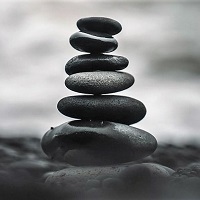 There are three traditional levels or degrees of Usui Reiki training, beginning with Level 1 and working up to Master Level, although the final level can be split into two teachings (see below). No previous experience is necessary and anyone can commence their reiki journey regardless of background, culture, intellect, spiritual or religious beliefs. To find out how to learn reiki and if it’s for you, it’s a good idea to become familiar with the basics first. (see An Introduction to Usui Reiki – Spiritual Healing.)
There are three traditional levels or degrees of Usui Reiki training, beginning with Level 1 and working up to Master Level, although the final level can be split into two teachings (see below). No previous experience is necessary and anyone can commence their reiki journey regardless of background, culture, intellect, spiritual or religious beliefs. To find out how to learn reiki and if it’s for you, it’s a good idea to become familiar with the basics first. (see An Introduction to Usui Reiki – Spiritual Healing.)
Should you decide to proceed with training the next logical step is to find the right Reiki Master. Look around, do your research, ask friends and family if they can recommend anyone. Have a look at the Therapy Jet Directory page for details of reiki organisations. If you’re in the U.K. check out The Reiki Guild’s website (www.thereikiguild.co.uk) or the U.K. Reiki Federation (www.reikifed.co.uk.) For worldwide listings see the International Association of Reiki Professionals (I.A.R.P.) website www.iarp.org.
As your interest in reiki grows, you may become aware of certain associations with others involved with reiki, with friends of friends or even complete strangers helping you to find your path. This could simply be coincidence or possibly the universe pointing you in the right direction! (It’s worth mentioning that certain elements of reiki healing seem to defy logic, so if you have an open mind and are responsive to unconventional ways of thinking, these qualities will serve you well!)
However you come across your teacher, it’s vital that you have a connection with them and that you’re happy with the way their training is carried out. Different teachers have different approaches and structure their courses accordingly. Traditionally Level 1 and 2 training was delivered one-to-one or in small groups over a period of 2 to 5 days, but open-ended online courses are becoming more popular today.

Online learning is really handy if you want to study at your own pace and are limited by when / where you can attend training. On the other hand these courses can seem impersonal. There are pros and cons to both approaches so it’s important to find a system that works for you.
It’s also important to note that a good Reiki Master will be available to support you after your training has finished. Should you decide to progress through the different levels of reiki, you may feel more comfortable with the same teacher, or you may decide you would like to experience a different approach. Go with what feels right for you.
First Degree Reiki Training – Initiation and Self Treatment
There are two main purposes to this level; first the teacher opens up the healing channels bringing the student’s unique energy vibrations in line with those of the reiki energy. Secondly the focus at this level is on self-treatment and to clear any blockages the student may have in order for the reiki to flow better. As well as treating the self, at this level trainees can practice on friends and family in a non-professional capacity.
A First Degree Reiki course should include the following:
 Discussion on the basics – origins, what it is, how it works etc.
Discussion on the basics – origins, what it is, how it works etc.- 1- 4 initiation(s) to open the healing channels
- Instruction on intention and visualisation
- Explanation of the chakras and meridians (energy centres / pathways within our bodies)
- Explanation of hand positions for treatments
- Demonstration of (partial) treatment from the teacher
- Practice of (partial) treatment from the student
- Questions and answers throughout
Students are often encouraged to keep a journal for treatments and personal revelations as this is useful for reflection and self-development.
Although there are no fixed timescales, a minimum period of three months is generally considered acceptable between Level 1 and Level 2 training. This way the energies are given time to “settle” and the student can prepare for a more intense energy as they progress.
Second Degree Reiki – A Deeper Commitment
The second degree is also known as the Practitioner Level. At this stage the student is ready to develop their existing knowledge and skills further, having begun their own healing process. They are more committed to the reiki path and may wish to practice on a professional level.
A Second Degree Reiki course should include the following:
- Discussion on case studies, experiences and personal development since completing First Degree
- Discussion on the differences between First and Second Levels
- 1-2 initiation(s) – to open healing channels further
- Further instruction on healing and procedures
- Introduction of the first three *sacred Usui Reiki symbols
- Instruction on how to use symbols including distance and group healing
- Instruction on becoming a professional practitioner
- Questions and answers throughout
It is generally expected that a minimum period of 6 months passes between Levels 2 and 3, although again there are no set timescales.
Third Degree – Master Practitioner and Master Teacher
 The Third Level involves an even deeper and usually more spiritual commitment to reiki whereby the student has adopted the principles and beliefs of reiki into their everyday lives. Reiki is no longer simply a healing method, but a lifestyle. Many wishing to train towards Third Degree are ready to dedicate their lives to reiki. This is a big responsibility not to be taken lightly; a good teacher should ask how and why their student has arrived at this point and ensure they are ready for the next stage.
The Third Level involves an even deeper and usually more spiritual commitment to reiki whereby the student has adopted the principles and beliefs of reiki into their everyday lives. Reiki is no longer simply a healing method, but a lifestyle. Many wishing to train towards Third Degree are ready to dedicate their lives to reiki. This is a big responsibility not to be taken lightly; a good teacher should ask how and why their student has arrived at this point and ensure they are ready for the next stage.
A Master Practitioner course should include the following:
- Discussion regarding the responsibilities and commitments of the Master Practitioner
- As with Second Degree, reflection and discussion on the journey so far including personal experiences, self development, case studies and observations
- 1-2 initiation(s) – to allow the higher level of reiki to flow through
- Introduction of the *sacred Reiki Master symbol and how to work with it
To progress from Master Practitioner to Master Teacher, the course should also include:
- Discussion regarding the responsibilities and commitments of the Reiki Master Teacher
- Instruction in delivery of training and initiating / attuning others
- Observations of the Master in a teaching environment
- Development of own Level 1 and 2 courses
- Observation by the Master when delivering the above
The length of training can vary considerably; some courses may be completed online quickly, or the student may work in the form of an apprenticeship shadowing and assisting the master for a year or more as would have been the case in times before.
Some Other Points To Be Aware Of…
- Regarding the *sacred Usui Reiki symbols, these are used in order to strengthen the reiki connection with a particular purpose in mind; for example, the distance symbol may be used as part of the distance healing process. These symbols were intended to be seen by the initiated only. Although they are now easy to find on the internet, I have chosen not to display them on these pages as a sign of respect to this tradition.
- For 21 days after each level of training there is a period of transition where energies are settling and students become accustomed to the higher vibrations they have been attuned to. By carrying out self-treatments daily, the maximum benefit can be gained from this period.
 Students should also be made aware that they may experience side effects either directly after training or in the following days. These are not serious and are often not experienced at all, but there may be some signs of “unblocking”. Perhaps the trainee will need to go to the toilet more, or they could get a runny nose or develop a cold. The master should explain these possible symptoms as they are a natural part of the detoxification process. Help your system by drinking plenty of water, avoiding stimulants and eating light meals.
Students should also be made aware that they may experience side effects either directly after training or in the following days. These are not serious and are often not experienced at all, but there may be some signs of “unblocking”. Perhaps the trainee will need to go to the toilet more, or they could get a runny nose or develop a cold. The master should explain these possible symptoms as they are a natural part of the detoxification process. Help your system by drinking plenty of water, avoiding stimulants and eating light meals.
Next Steps – Is Reiki For You?
So, if you’re considering starting your own reiki journey, you should be aware of the basics and whether or not it’s for you. Remember, make sure you find the right Reiki Master and as you progress through the training, do not rush, do not see it as a race but more an evolution of the skills you’re learning and hopefully of yourself as a whole person.
Even when the Master Level is completed, that’s not the end of the road and reiki has not actually been “mastered.” It’s an ongoing process of self-awareness and development.
There are many variations which have developed from Usui Reiki. Some examples are Kundalini, Shamballa, Rainbow, Karuna and Gendai Reiki. I will be covering each of these as the site develops, but know for now that these versions also follow the holistic approach to healing using energy that is directed and focused for the greater good.
Finally, I sincerely hope you’ve found this article useful. Please leave your comments, feedback and / or questions below – I would love to hear from you. In the meantime, allow me to wish you a very interesting and enlightening future as you commence or continue your personal reiki journey.




